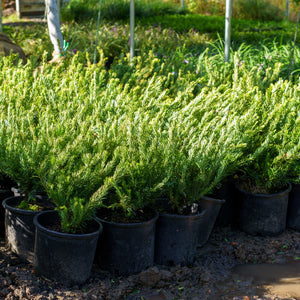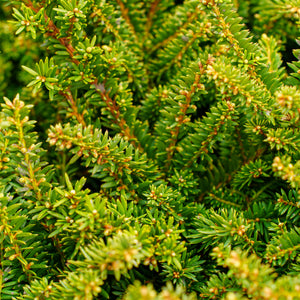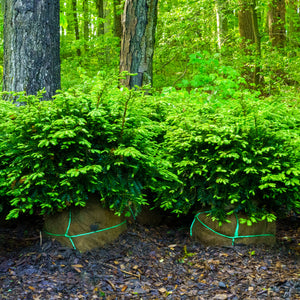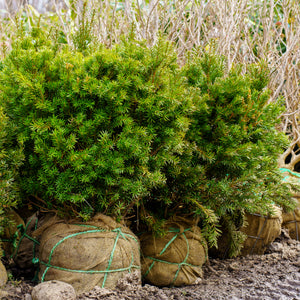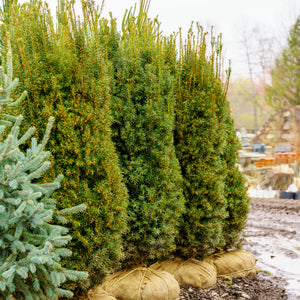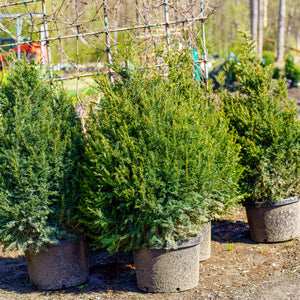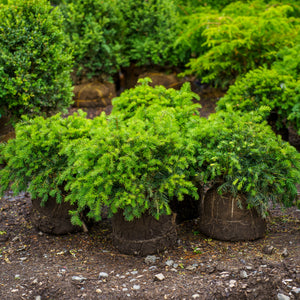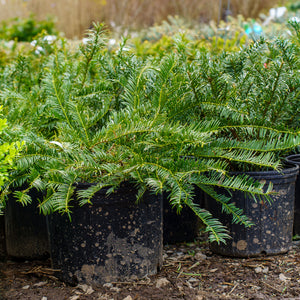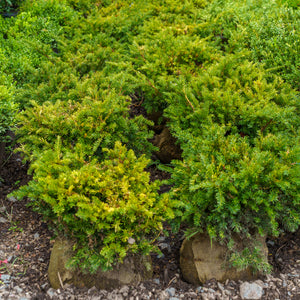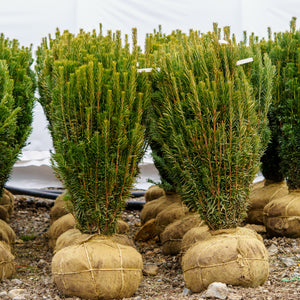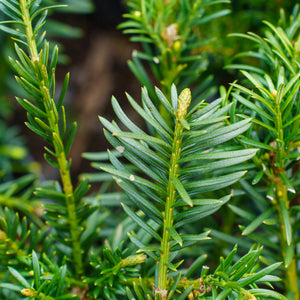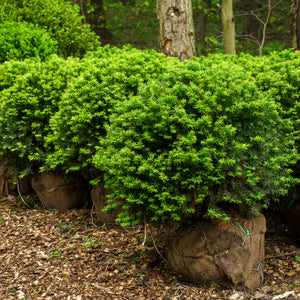The Yew Guide
Yew trees, with their timeless beauty and remarkable characteristics, bring an air of elegance and permanence to any landscape. Standing tall and proud, adorned with dark green foliage and boasting unique features, yew trees have the power to captivate and transform gardens and outdoor spaces. These extraordinary trees are cherished for their versatility and adaptability, flourishing in various environments when given proper care and consideration. Whether you seek a tranquil sanctuary amidst a woodland setting or a captivating centerpiece for your garden, yew trees are an exceptional choice that will leave an indelible mark. With their enduring presence and inherent allure, yew trees embody the essence of grace and grandeur, enriching your outdoor environment in ways that are both remarkable and unforgettable.
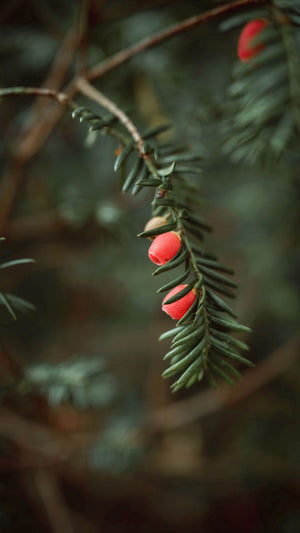
About
Yew trees, belonging to the Taxus genus, are a diverse group of evergreen trees renowned for their timeless presence and ecological significance. With various recognized species, yew trees can be found in temperate regions across the Northern Hemisphere, including North America, Europe, and Asia. These magnificent trees possess distinctive attributes that contribute to their overall allure and play a vital role in supporting local ecosystems.
One of the defining characteristics of yew trees is their striking foliage, which consists of dark green needles arranged in a dense and elegant manner. The foliage remains vibrant and lush throughout the year, adding a touch of verdant beauty to any landscape. Additionally, yew trees display unique red berries, known as arils, which provide a source of sustenance for birds and other wildlife during the winter months.
Yew trees hold great ecological importance as they provide shelter and food for a wide range of wildlife. The dense foliage offers nesting sites for birds, while the berries attract various species, contributing to the biodiversity of the surrounding environment. Furthermore, yew trees have a long history of cultural significance and have been revered for their medicinal properties and use in traditional herbal remedies.
These versatile trees exhibit adaptability to different soil types and environmental conditions. Yew trees can thrive in both sun and shade, making them suitable for various garden settings. They prefer well-drained soil but can tolerate a range of soil pH levels. Additionally, yew trees have the ability to withstand harsh climates and can be found growing in both coastal and mountainous regions.
Whether utilized as a striking focal point, planted in hedges for privacy, or incorporated into mixed borders, yew trees bring an element of sophistication and timeless beauty to any landscape. Popular species of yew trees include the English yew (Taxus baccata) and the Japanese yew (Taxus cuspidata), each with its own distinct characteristics and ornamental value.
By carefully selecting and nurturing yew trees in your landscape, you not only enhance the aesthetic appeal of your outdoor space but also contribute to the preservation of these remarkable trees and the intricate ecosystems they support. The enduring presence and ecological significance of yew trees make them a valuable addition to any garden or landscape, leaving a lasting impression for generations to come.
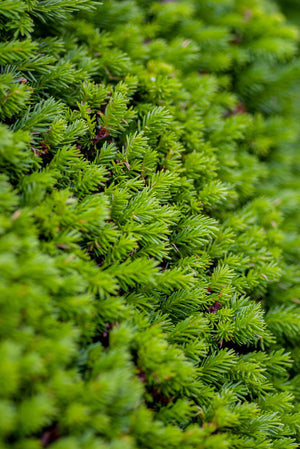
Planting
Yew trees have specific planting requirements to ensure their successful establishment and growth. Here are some general guidelines for planting and caring for yew trees:
Soil: Yew trees thrive in well-drained soil that is moderately fertile. They can tolerate a range of soil types, including loam, clay, and sandy soil. Before planting, ensure that the soil is well-drained and not prone to waterlogging. Improve the soil's drainage and fertility by incorporating organic matter, such as compost or well-rotted manure.
Sunlight: Yew trees are adaptable to different light conditions. While they prefer partial shade to full sun, they can also tolerate some shade. Choose a planting location that receives at least a few hours of direct sunlight each day, especially in the morning or late afternoon.
Watering: Adequate watering is essential during the early stages of yew tree establishment. After planting, water the tree thoroughly to settle the soil and encourage root growth. Provide regular irrigation during dry periods, especially in the first year. Water deeply once or twice a week, ensuring that the soil remains moist but not waterlogged. Adjust the frequency based on rainfall and soil moisture levels.
Mulching: Apply a layer of organic mulch around the base of your yew tree to conserve moisture, suppress weed growth, and regulate soil temperature. Use wood chips, bark, or compost as mulch, spreading it evenly around the tree. Keep the mulch a few inches away from the trunk to prevent excess moisture buildup and potential rotting.
Pruning: Yew trees are naturally dense and have a compact growth habit, requiring minimal pruning. However, you can prune them to maintain their desired shape and size. Prune yew trees during late winter or early spring while they are still dormant. Remove any dead, damaged, or crossing branches to promote air circulation and maintain a balanced structure. Use clean and sharp pruning tools to minimize the risk of infections.
By following these basic planting and care guidelines, you can ensure the successful establishment and healthy growth of your yew trees. With proper care, your yew trees will flourish and contribute to the beauty and elegance of your landscape for many years to come.
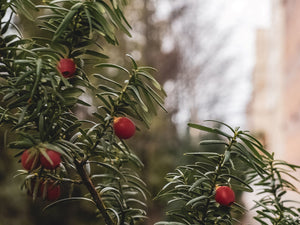
Care
Yew requires specific care to ensure its optimal growth and health. Here are some general guidelines for caring for yew:
Watering: Yew has moderate water needs. Water it deeply and thoroughly, providing enough water to penetrate the root zone. During dry periods, water it regularly, ensuring that the soil remains consistently moist but not waterlogged. Avoid overwatering, as it can lead to root rot and other issues.
Pruning: Yew has a naturally dense and compact growth habit, requiring minimal pruning. However, you can prune it to maintain its shape and remove any dead, damaged, or diseased branches. Prune yew during late winter or early spring while it is still dormant. Use clean and sharp pruning tools to minimize the risk of infections.
Fertilizing: Yew generally does not require frequent fertilization. However, if the soil is deficient in nutrients, you can apply a balanced, slow-release fertilizer in the spring. Follow the manufacturer's instructions for the appropriate application rate. Avoid excessive fertilization, as it can lead to excessive foliage growth and weak branches.
Soil and Sunlight: Yew is adaptable to a range of soil types but prefers well-drained soil. Ensure good drainage to prevent waterlogging, which can cause root rot. Yew can tolerate both full sun and partial shade. However, it tends to perform best in partial shade, especially in hot and dry regions.
Mulching: Apply a layer of organic mulch around the base of your yew, keeping it a few inches away from the trunk. Mulch helps conserve moisture, suppress weed growth, and regulate soil temperature. Use wood chips, bark, or compost as mulch, replenishing it periodically to maintain a depth of 2-4 inches.
Pests and Diseases: Yew is generally resistant to pests and diseases. However, it's important to monitor for common issues such as scale insects or fungal diseases like root rot or needle blight. Regularly inspect your yew for any signs of damage or disease and take appropriate measures if needed. Maintaining good plant health through proper watering, pruning, and soil care can help prevent and manage pest and disease issues.
By following these basic care guidelines, your yew will thrive, providing enduring beauty and a sense of grandeur in your landscape.
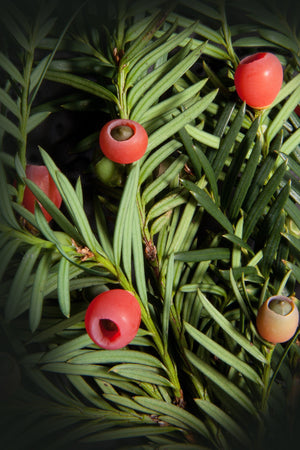
How To Use
Yew offers versatility and can be used in various ways to enhance your landscape. Here are some recommendations based on its characteristics:
Focal Point: Yew makes an excellent focal point in your landscape due to its dense foliage and unique form. Plant a single yew in a prominent location to create a captivating centerpiece that adds a sense of elegance and sophistication to your garden.
Privacy Hedge: Utilize the dense growth habit of yew to create a natural privacy hedge. Plant a row of yew shrubs along your property line to create an attractive and effective barrier that provides privacy and blocks unwanted views.
Topiary and Sculpting: Yew's dense and malleable foliage makes it well-suited for topiary and sculpting. Trim and shape yew into desired forms such as geometric shapes, animals, or other artistic designs to add a touch of creativity and artistic expression to your landscape.
Container Planting: Yew can be grown in containers, making it a versatile choice for patios, balconies, or small gardens. Select a compact yew variety and plant it in a large container to create a focal point or add greenery to confined spaces.
Foundation Planting: Yew is an excellent choice for foundation planting around your home. Its compact growth habit and evergreen foliage provide year-round interest and help soften the lines of your house, creating a cohesive and inviting look.
Low-Maintenance Landscaping: Yew is known for its low-maintenance nature. Use yew as a reliable and easy-care element in your landscape design. It requires minimal pruning and can thrive in a variety of soil conditions, making it an ideal choice for busy gardeners or those seeking a low-maintenance garden.
Formal Gardens: Yew's symmetrical and formal growth habit lends itself well to formal garden designs. Use yew to create hedges, parterres, or geometric patterns that define and structure the space, adding a touch of elegance and order to your garden.
By considering yew's growth habits and characteristics, you can select the appropriate variety and utilize it in various ways to enhance the aesthetics and functionality of your landscape. Whether as a focal point, privacy hedge, topiary, or part of a low-maintenance design, yew brings timeless beauty and versatility to your outdoor environment.
Conclusion
Yew is a captivating and versatile addition to any landscape. With its dense foliage, unique form, and timeless appeal, yew is highly valued for its beauty and multiple practical uses. By following proper planting and care practices, you can fully harness the potential of yew to enhance your outdoor space and create a lasting impression. Whether you desire an eye-catching focal point or a natural privacy screen, yew can fulfill various roles in your landscape design. Plant a single yew shrub in a prominent location to showcase its elegant foliage and create a visually striking centerpiece. Alternatively, arrange multiple yew shrubs together to create a dense and captivating effect. Yew's dense growth and evergreen foliage make it ideal for creating privacy hedges or windbreaks, shielding your garden or outdoor living spaces from unwanted views and strong winds. Additionally, yew's compact size and adaptability to container planting make it a great choice for adding greenery to patios, balconies, or small gardens. Furthermore, yew's low-maintenance nature and tolerance for various soil conditions make it a reliable and easy-care option for any gardener. Whether you incorporate yew into formal gardens, sculpt it into artistic shapes, or simply let it thrive in its natural form, yew brings enduring beauty and versatility to your outdoor environment. Embrace the elegance and functionality of yew, and enjoy the timeless charm it brings to your landscape for years to come.

